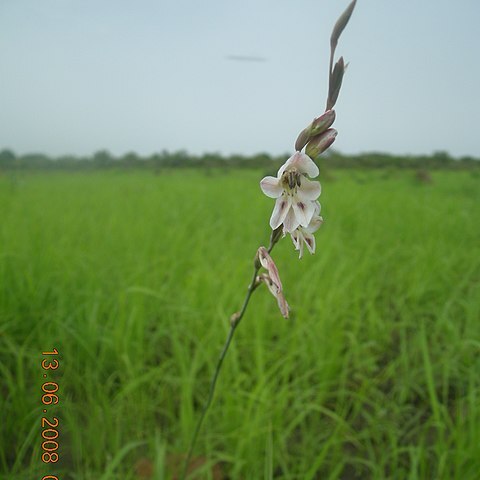Flowers cream to light-purple, the upper tepals flushed light-to deep-purple, the lower each with deep-purple spear-shaped marking in the upper third, surrounded by a lighter area, sometimes with a dark spot at the base of the uppermost tepal, flowers windowed when viewed in profile, with a gap between the uppermost tepal and the upper lateral tepals; perianth tube c. 10 mm long, curving outward from between the bracts, widening near the mouth; tepals unequal, the uppermost 18–20(24) × (8)10–12 mm, larger than the others and arched over the stamens and style and much narrower toward the base, the upper lateral tepals smaller, joined to the lower 3 for 3–5 mm, directed forward and ultimately curving outwards, the lower 3 tepals smaller than the others, usually exceeding the uppermost when viewed in profile, 10–12 mm long, usually united for 1–2 mm, horizontal or directed downward distally, narrowed below into claws, the limbs abruptly expanded.
Leaves of the flowering stem are usually short, entirely stem sheathing and hardly distinguishable from the cataphylls, or these sometimes with a short isobilateral blade, rarely do 2 basal leaves become fairly well developed and with blades exceeding the sheaths; sheathing leaves 3–5, usually 6–9 cm long, the lower ones exceeding the internodes, the upper ones shorter than the internodes, thus imbricate below but rarely so above, sometimes the lower ones with blades up to 4 cm long; (1)2–3 foliage leaves are produced on separate shoots after the plants have flowered (hysteranthous leaves), these ultimately 30–45 cm long and 4–8(12) mm wide, linear to narrowly lanceolate, with margins and midrib slightly thickened and hyaline.
A herb. It keeps growing from year to year. It grows 30-60 cm high. The corms are 15-25 mm across. The leaves develop on separate shoots after the flowering. There are up to 18 flowers on a stalk. They are purple and have some white parts.
Corms 15–25(35) mm in diameter, often dark-red on the outside and sometimes internally; tunics red-brown, membranous and irregularly broken or fibrous and reticulate.
Style dividing opposite the lower half of the anthers; style branches 2–2.5 mm long, reaching to between the middle and apices of the anthers.
Spike 10–18-flowered; bracts green, 10–15 mm long, the inner somewhat shorter than, to nearly equalling, the outer in length.
Filaments 10–12 mm long, exserted 4–5 mm; anthers yellow, 6–8 mm long.
Capsules 12–16 mm long, ellipsoid-ovoid.
Flowers dull purple fading to white
Slender herb about 1 ft. high
Stem erect, rarely branched.
Plants 30–60 cm high.

